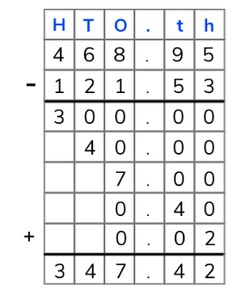
Subtraction with decimal numbers to the hundredths place
Learn to subtract decimal numbers to hundredths place using partial differences.



8,000 schools use Gynzy
92,000 teachers use Gynzy
1,600,000 students use Gynzy
General
Students learn to use partial differences when subtracting decimal numbers to the hundredths place.
Common core standard(s)
5.NBT.B.7
Relevance
It is important to learn how to use partial differences because it allows you to easily subtract decimal numbers that are difficult to subtract in your head or in one step.
Introduction
The interactive whiteboard shows three rows of decimal numbers. Each row has listed the first three decimal numbers. Students must complete the next three decimal numbers in the row. Ask students how large the jump between numbers is and how they determined that.
Development
Explain to students that when subtracting using partial differences that you write the numbers one below the other. Then you subtract from left to right. Tell students that you write the largest number on the top and the smaller number on the bottom. In this case, you start subtracting at the hundreds. Subtract these numbers. Then subtract the tens, ones, the tenths, and hundredths. It is possible when subtracting ones that your bottom number is greater than your top number. You can choose two options to explain this to the students. Option 1: Tell students that you subtract the two and get a negative number which you mark with a minus sign. Option 2: Tell students to "swap" the numbers in their head (setting the larger number above the smaller number) and mark this swap in the column with a minus sign. When you have written all of these partial sums in the boxes provided, you tell students to follow the signs they've written. So the negative numbers, or numbers with the minus sign (depending on your explanation) are subtracted from the numbers with a plus sign (or without any sign). All together, these numbers total your difference. Show students a problem in which the problem is written in but where they need to write in the partial differences. Ask students to write down the partial differences on a sheet of paper and hold them up so that they can be checked. Next show three problems that students must solve using partial differences where the problems have already been written into the boxes. Then have students complete an entire problem including writing the problems into the boxes. At the end challenge students with a problem which has three numbers.
Check that students are able to subtract decimal numbers to the hundredths place using partial differences by asking the following questions/giving the following tasks:
- Why is it useful to subtract using partial differences?
- Which side do you start when using partial differences?
- Solve the problems: 543.85- 221.64 = ? and 754.85 - 331.56 = ?
Guided practice
Students practice subtracting decimal numbers using partial differences by being asked to fill in the partial differences in given problems, by writing in the partial differences and total difference, and by writing in the problem and then solving using partial differences.
Closing
Discuss with students that it is important to be able to subtract numbers to the hundredths place using partial differences, so that they can more easily find the difference between larger numbers. Check that students know to start solving on the left when using partial differences and that when the number on the bottom is larger than the number on the top that they write the negative number and subtract that (or add the negative number) from the others. The interactive whiteboard shows a farmer talking about how many pounds of apples they have harvested, and how many pounds have been sold. Students use partial differences to determine how many pounds of apples the farmer has left. Repeat this with strawberries.
Teaching tips
Students who have difficulty with subtracting using partial differences can be supported by refreshing the place value (H,T,O) of numbers and how they belong in a place value chart. Students can also be helped by going through the process of subtracting a larger number from a smaller number. When the number on the bottom is larger than the number on the top it is easiest to explain to students that they need to "swap" the numbers and subtract. But that they must mark that with a minus sign in the boxes where they write their partial difference.
The online teaching platform for interactive whiteboards and displays in schools
Save time building lessons
Manage the classroom more efficiently
Increase student engagement
Discover more!
About Gynzy
Gynzy is an online teaching platform for interactive whiteboards and displays in schools.
With a focus on elementary education, Gynzy’s Whiteboard, digital tools, and activities make it easy for teachers to save time building lessons, increase student engagement, and make classroom management more efficient.



